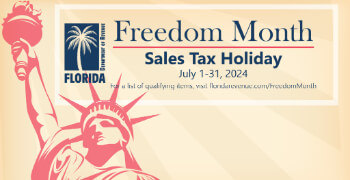
What do you need to know about sales and use tax returns?
One thing they don’t tell you about becoming a small business owner is how much tax paperwork you’ll be expected to do. You may have been lured into the small biz life with promises of making your own schedule and building a business you’re passionate about — maybe you’re sharing your art with the universe or curating the perfect selection of gifts or taking your love of landscaping out into the world. But whether you like it or not, small business owners are also managing sales and use tax compliance.
This blog post will walk you through the basics of small business sales tax filing, including what it takes to get a sales tax permit and how often you should pay sales tax and file a tax return, and it can give you a few helpful hints for managing business taxes along the way.
- What do you need to know about filing sales tax returns?
- What is nexus?
- What do you have to do when you establish sales tax nexus?
- What is a sales and use tax return?
- How do I file sales tax returns?
- How do I register to file sales tax returns for my small business?
- What are sales tax filing due dates?
- What terms do I need to know?
What do you need to know about filing sales tax returns?
Years ago, small businesses may have flown under the tax radar, not making enough sales for business owners to worry about collecting and remitting sales tax in states other than their home state — even when they’d sell online. A lot has changed since then, mainly thanks to the 2018 United States Supreme Court decision in South Dakota v. Wayfair, Inc. The court ruled that states have the authority to impose sales tax collection obligations on businesses with no physical presence in the state as well as on businesses with physical presence in the state.
So what does that mean for small businesses like yours (and business taxes)? Sales tax compliance has gotten much more complex for businesses, especially if you make online sales or have a broad customer base.
What is nexus?
Before the Wayfair decision, states typically couldn’t require a business to collect sales tax if the business did not have a physical tie to the state (known as physical nexus), like employees, inventory, or an office. Now states can base a sales tax obligation solely on a remote seller’s (aka out-of-state seller’s) economic activity in that state (called economic nexus).
Today, every state with sales tax has some sort of sales tax nexus laws on the books. Usually, they require a business to collect sales tax and remit the tax in a state if the business reaches a nexus threshold, or a preset number of transactions or amount of sales. Each state’s economic nexus sales threshold amount is unique:
- It’s $500,000 in sales in California and Texas
- It’s $100,000 in sales in Iowa and Washington
- It’s $100,000 in sales or 200 transactions in Georgia and Virginia
This is especially important to note if you sell online; a threshold of $100,000 or 200 transactions can affect even very small online sellers. And once a business crosses a nexus threshold in a state, it must register, collect sales taxes, report sales tax, and file returns in that state.
A small operation can easily have significant sales in all 50 states, making sales tax compliance that much more complicated. A small business owner must constantly monitor their sales across many states to gauge how close they are to meeting nexus thresholds and local tax requirements. If you’re not sure where to start, a sales tax risk assessment can help.
What do you have to do when you establish sales tax nexus?
Once nexus has been determined, you should:
- Register with the tax authority to get a sales tax permit (some states require you to register as soon as you establish economic nexus)
- Correctly calculate sales tax, applying the proper rate to each taxable transaction
- Validate exempt sales, collecting exemption certificates from new customers and renewing older certificates as required
- File returns and remit the sales tax you collected (pay sales tax to the state) by the appropriate due dates
What is a sales and use tax return?
When you collect sales taxes, your business holds on to the funds until you can file a return and pay the sales tax to the tax authority or state’s taxing agency. A sales tax return specifies the amount of tax your company owes to the state based on the amount of taxable sales your business has made.
So if you sold 100 novelty T-shirts at $20 each with an 8% sales tax rate, you’d have collected $160 in sales tax that you have to pass on to the state or local jurisdiction. Most sales tax calculations aren’t that simple, however. If you sell a variety of goods and services, they may be taxed at different rates. And if you sell into multiple jurisdictions with different rates, your tax forms just got that much more complicated.
You’ll likely have to report use tax as well. Use tax is a tax on taxable goods and services that are consumed, stored, or used in the jurisdiction, like when an employee in your retail business grabs a package of paper towels off the sales shelf to use in the break room, or when your business buys equipment in a state that doesn’t charge sales tax and uses it in a state that does. The use tax return captures that lost tax revenue.
How do I file sales tax returns?
Step 1: Register with the correct tax authority. It’s actually illegal to collect sales tax in a state if you’re not registered there, so be sure to get your sales tax permit.
Step 2: Correctly calculate sales tax, applying the proper rate to each taxable transaction. Collecting sales tax may sound easy, but if you’re doing it manually, you may be spending a fair amount of time looking up sales tax rates and deciphering tax rate tables on Department of Revenue websites. The easiest and most accurate way to apply the correct sales tax rate every time is to use software that automatically applies sales taxes to sales and bases the calculations off the appropriate sourcing rules. Learn more about collecting and paying sales tax.
Step 3: Validate exempt sales, collect exemption certificates from new customers, renew old certificates as required. If you have sales-tax-exempt customers or make exempt sales, you’ll need detailed records. You’ll have to collect, validate, and store exemption certificates from your customers. Since most states have varying requirements for exemption certificate validation (some expire yearly, some don’t expire at all), you’ll need to track the requirements in each state where you file.
Step 4: File returns and remit the collected tax by the due date. It’s time to file! It’s also time to file next month!. Basically, each state has its own sales tax returns due dates, and filing frequency is typically based on the amount of business you have in a state. The more taxable sales you make, the more frequently you’ll need to file. Failure to file on time can result in late fees and fines in most states, so it’s important to track due dates across all the jurisdictions where you have to file for the tax year (or month, as the case may be).
It’s possible to do all of these steps manually, especially if your sales taxes aren’t complicated. But taxes can get very complicated very quickly, especially if you’re making online sales — one viral social media ad or a busy holiday shopping weekend can open you up to a ton of new tax obligations, and your spreadsheet and filing cabinet systems might not cut it. Consider an automated solution that can calculate and apply sales taxes automatically, collect and validate exemption certificates for you, and help you file your tax returns on time in every jurisdiction where you owe.
Note: If you’re registered for sales tax in a state, you may need to submit a return for sales and use tax, even if the amount taxed is $0. This is called a zero return, and it just tells the taxing jurisdiction you had no income or limited income from sales.
How do I register to file sales tax returns for my small business?
Your registration journey will typically start on the state Department of Revenue (DOR) website. Or likely, on many state DOR websites (if you have a particular love of paperwork and want to fill out a paper form, in some states, you can mail in your forms). Each state has a different application and process for sales tax registration, but in general, you’ll need to have on hand your federal tax ID, or EIN, business owner information, and other information.
This is another sales tax step where automation could come in handy, saving small business owners like you time, money, and effort. Instead of hunting down and filling out near duplicates of forms for a number of states, a software solution like Avalara Business Licenses can help you file for multiple states with just one form.
Note: Streamlined Sales Tax (SST) is a state-run program that can help make sales tax compliance easier and more affordable. Participating states will offset the cost of using a sales tax compliance software like Avalara for qualifying businesses. Learn more about the program.
What are sales tax filing due dates?
Sales tax filing due dates vary by state. It’s important to know whether your states require you to file quarterly, twice a year, or seasonally, based on your business activity in the state. For state-specific information, including state and city sales tax rates, check out our state rate pages.
New to this topic? Here are some terms you’ll want to know:
sales tax: a tax imposed on the sale of goods and services, usually a percentage of the purchase price; sales tax rates vary by jurisdiction and type of product.
use tax: a tax imposed on the use of taxable goods and services when sales tax has not been paid
sales tax return: a form filed with the tax authority that reports how much sales tax a business has collected on goods or services sold
remittance: the act of transferring sales tax collected to the tax authority
South Dakota v. Wayfair, Inc.: the 2018 U.S. Supreme Court case that allowed states to tax remote sales and establish economic nexus laws
economic nexus: an economic connection between a business and a state that establishes a tax obligation, such as having a certain amount or number of sales in that state
physical nexus: a physical connection between a business and a state that establishes a tax obligation, such as having employees, storing inventory, or having headquarters in that state
A better way for small businesses to file returns
Does all of this sound daunting? That’s no surprise; sales taxes are complicated, and learning how to collect sales tax, remit sales tax, and file returns for your small business can be a little overwhelming. Many small business owners are turning to automation to help keep them tax compliant, and that’s where Avalara comes in.
Avalara Returns is a smarter way for small businesses, and marketplaces to handle sales and use tax returns by streamlining preparation, reporting, and filing process with an integration that works with the ERP you already use, plus marketplaces like Amazon, Etsy, and Walmart. Avalara Returns can help eliminate the hassle of filing separate returns with each state, while reducing the risk of human error and the time spent on each return.

Avalara Tax Changes 2024: Get your copy now
Stay ahead of 2024’s biggest tax changes with this comprehensive, compelling report covering seven industries.
Stay up to date
Sign up for our free newsletter and stay up to date with the latest tax news.












